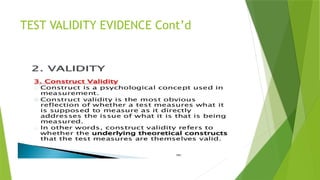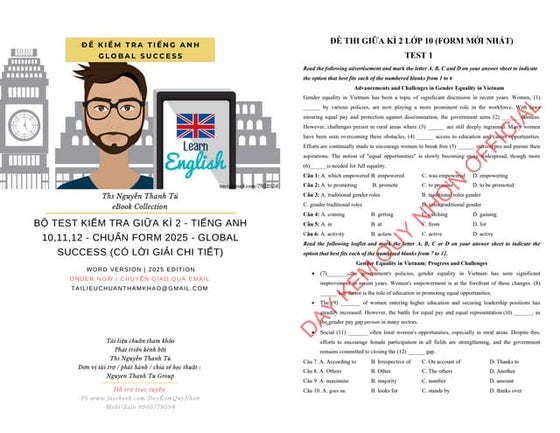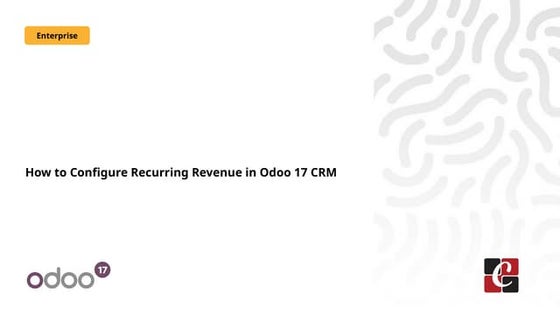MCHS 2 General Principes in Assessment.pptx
Download as PPTX, PDF0 likes6 views
Principles of assessment in education
1 of 44
Download to read offline












































Recommended
ELTLAE Group 2.pptx



ELTLAE Group 2.pptxAhzaPutro
╠²
This document discusses key concepts and principles of assessment for English language learners. It begins by explaining why assessment should take place, noting that it is used to measure learning and improve instruction. It then covers key concepts involved in assessment like accountability, achievement, and different assessment types and strategies. Several principles of assessment are outlined, including being ethical, fair, valid, reliable and practical. The document concludes by providing checklists to evaluate if classroom tests are applying these principles of practicality, reliability, validity, authenticity, and having a beneficial washback effect on learning.Principles of Assessment



Principles of AssessmentDr. Amjad Ali Arain
╠²
Topic: Principles of Assessment
Student Name: Syed Faizan Ali
Class: B.Ed. Hons Elementary Part (II)
Project Name: ŌĆ£Young Teachers' Professional Development (TPD)"
"Project Founder: Prof. Dr. Amjad Ali Arain
Faculty of Education, University of Sindh, Pakistan
Evaluation of educational programmes in nursing course and programme-ppt



Evaluation of educational programmes in nursing course and programme-pptkirukki
╠²
- In 1860, Florence Nightingale established the first nursing school which focused on hygiene, tasks, and practice. Others later advocated for higher education-based nursing programs.
- There are different models for evaluating nursing education programs which consider priorities, timelines, personnel, and resources. Evaluation is used for accreditation, budgeting, developing faculty/staff, and improving programs.
- Proper evaluation is important to facilitate learning, diagnose issues, make decisions, improve outcomes, and judge effectiveness through formative and summative assessments. Standards ensure evaluations are useful, feasible, proper, and accurate.Validity, reliabiltiy and alignment to determine the effectiveness of assessment



Validity, reliabiltiy and alignment to determine the effectiveness of assessmentMirea Mizushima
╠²
The document discusses the importance of validity, reliability, and alignment in determining the effectiveness of assessments. It defines validity as measuring what is intended, reliability as consistency, and alignment as connecting objectives, activities, and assessments. The document provides details on factors affecting and types of validity, reliability, and strategies for developing effective assessments aligned to standards through higher-order skills, critical abilities, international benchmarks, and instructionally sensitive tasks.Establishment of IQAC and Self Assessment at Program Level



Establishment of IQAC and Self Assessment at Program LevelPavithra M. R
╠²
This document discusses quality assurance and self-assessment in higher education. It outlines the key components of establishing a quality assurance mechanism, including institutionalizing an Internal Quality Assurance Cell (IQAC) and forming a Quality Assurance Coordination Committee. The IQAC would help promote quality culture, ensure good practices, and prepare programs and the university to meet external quality assessment requirements. Self-assessment is presented as an ongoing process for programs to monitor and improve student learning through collecting empirical data on student attainment and using it to enhance the program. Guidelines are provided for conducting self-assessment, developing a self-assessment report, undergoing external peer review, and creating an improvement plan.Determinants of Lecturers Assessment Practice in Higher Education in Somalia



Determinants of Lecturers Assessment Practice in Higher Education in Somaliaijejournal
╠²
The document summarizes a research study that investigated the determinants of lecturers' assessment practices in higher education institutions in Mogadishu, Somalia. The study found that assessment design, interpretation, application, and administration were significant determinants of lecturers' assessment practices. A survey of 314 lecturers from public and private universities was conducted. Results showed that assessment design, interpretation, and application had a strong positive relationship with lecturers' assessment practices. The study concluded that focusing on in-service training to improve lecturers' skills in assessment practices could help upgrade assessment in Somali higher education.A guide-to-internal-quality-assurance



A guide-to-internal-quality-assuranceIbrahim Khleifat
╠²
This document provides guidance on internal quality assurance processes for qualifications. It outlines the role of the Internal Quality Assurer to monitor delivery and certification, ensure assessor competence, and conduct quality checks. The document describes induction of new assessors and the importance of planning, conducting, and providing feedback for assessments. It also explains that sampling strategies are necessary to check assessment quality and consistency across learners, assessors, sites, and time periods.Online assignment



Online assignmentvazhichal12
╠²
1. The document discusses modern evaluation techniques like Continuous and Comprehensive Evaluation (CCE) and grading systems.
2. CCE aims to provide a holistic assessment of student development in both academic and non-academic areas over their time in school through continuous evaluation.
3. Grading systems communicate student achievement through standardized symbols and can involve direct grading by teachers, indirect grading by converting marks to grades, and relative grading based on student performance compared to peers.Measurement & Evaluation pptx



Measurement & Evaluation pptxAliimtiaz35
╠²
- Standardized tests are formal assessments administered under standardized conditions to large groups of students. They provide norm-referenced scores allowing comparison between students. Teacher-made tests are informal classroom assessments created by teachers.
- Standardized tests have established reliability and validity ensured through rigorous test construction procedures. Teacher tests may vary in reliability and validity.
- Standardized test results provide information on student achievement compared to peers. Teacher tests provide information on mastery of specific classroom content.Basic concepts in Assessments (Educ 9)



Basic concepts in Assessments (Educ 9)Roqui Gonzaga
╠²
Basic Concept in Assessment. There are four basic concept in assessment such as measurement, Evaluation, Assessment and also the Non-tests. It is being used as a guide to the teacher for them to be effective in their Assessment.Basic concepts in Assessments (Educ 9)



Basic concepts in Assessments (Educ 9)Roqui Gonzaga
╠²
Measurement involves quantifying observations about attributes to make determinations less ambiguous. Evaluation is a process of considering evidence in light of standards and goals. There are various types of evaluation including placement, formative, diagnostic, and summative. Placement evaluation determines students' existing knowledge and skills. Formative evaluation identifies errors and provides feedback during instruction. Diagnostic evaluation detects learning difficulties, while summative evaluation assesses achievement at the end of a period. Evaluation should be based on clear objectives, use appropriate procedures, be comprehensive, continuous, diagnostic, cooperative, and used judiciously to improve the learning process.ASSESSMENT and EVALUATION.pptx



ASSESSMENT and EVALUATION.pptxGIRLYCAMACHO
╠²
Assessment and evaluation involve systematically gathering information on student learning and performance to improve instruction. Standardized tests and methods are used to make valid comparisons. DepEd Order No. 8 s. 2015 provides guidelines for classroom assessment in the Philippine basic education program, distinguishing formative from summative assessment. Formative assessment informs teaching while summative assessment measures standards mastery. A variety of assessment strategies and performance tasks are used for a holistic understanding of student competencies.Concept and nature of measurment and evaluation (1)



Concept and nature of measurment and evaluation (1)dheerajvyas5
╠²
Measurement, evaluation, and assessment are related concepts aimed at judging student performance and progress. Measurement refers to obtaining quantitative data about a student's abilities or skills, such as a test score. Evaluation involves making qualitative judgments about a student's performance based on criteria. The purpose of evaluation and assessment includes student placement, certification, improving teaching, and providing feedback. Key principles of effective evaluation are that it should be planned, guided by learning outcomes, use multiple strategies, and help students by providing feedback.Quality assuring assessment guidelines for providers, revised 2013



Quality assuring assessment guidelines for providers, revised 2013Ibrahim Khleifat
╠²
This document provides guidelines for quality assuring assessment processes for education providers. It outlines the key stages of the assessment process, including assessment, authentication of results, results approval, appeals processes, and requesting certification. The guidelines emphasize principles of validity, reliability, fairness, quality, transparency, and complementarity. Providers are responsible for establishing assessment policies and procedures, while QQI (Quality and Qualifications Ireland) monitors providers to ensure national standards are upheld consistently.Quality assuring assessment guidelines for providers, revised 2013



Quality assuring assessment guidelines for providers, revised 2013Ibrahim Khleifat
╠²
This document provides guidelines for quality assuring assessment processes for awarding bodies. It outlines the key stages in the assessment process, including assessment, authentication of results, approval of results, appeals processes, and requesting certification. The guidelines emphasize principles of validity, reliability, fairness, quality, and transparency. Awarding bodies are responsible for establishing their own assessment policies and procedures in line with these guidelines, and QQI will quality assure providers' assessment processes to ensure standards are applied consistently nationally.Quality education



Quality educationDr Ashok Jetawat
╠²
Kingson (Maharaja) Group is committed to establishing a comprehensive platform for quality in higher education. They aim to [1] improve learning quality and efficiency through a systematic quality assurance approach, [2] introduce an enabling learning environment to support knowledge development, and [3] integrate quality components into all areas of development and policymaking. Quality assurance is a process of establishing stakeholder confidence by fulfilling expectations through input, process, and outcome reviews. It requires planning continuous improvement. The group's quality assurance functions include promoting degree standards, reviewing programs and affiliations, establishing standards and qualifications frameworks, and developing evaluation processes.Moving Towards Programmatic Assessment



Moving Towards Programmatic AssessmentMedCouncilCan
╠²
This document discusses the evolution of programmatic assessment in UK medical training over the past 30 years. It outlines how assessment has shifted from high-stakes exit exams to integrated programs that use workplace-based assessments like mini-CEX, DOPS, and CbD. Key organizations like the GMC, PMETB, and foundation program have developed principles of good assessment including assessing multiple competencies through various methods. The foundation program initially piloted four assessment tools but has since refined these to better provide feedback and identify trainees needing support. Overall, the document traces the progression towards valid programmatic assessment across medical education in the UK.Principle of Assessment Practice



Principle of Assessment PracticeS. Raj Kumar
╠²
Principles of Assessment Practice
Validity ensures that assessment tasks and associated criteria effectively measure student attainment of the intended learning outcomes at the appropriate level.Principles of language assessment.pdf



Principles of language assessment.pdfjlparra5
╠²
This document discusses key principles of language assessment including reliability, validity, practicality, authenticity, and washback effect. It defines key terms such as measurement, evaluation, formative and summative assessment. It also outlines different types of language assessments like achievement tests, diagnostic tests, placement tests, and proficiency tests. Finally, it provides a bibliography of references on principles of language assessment.Unit 2.pptx



Unit 2.pptxSamruddhi Chepe
╠²
Assessment and evaluation- A new perspective
Unit 2- Tests and its Application
Syllabus of Unit 2
Testing- Concept and Nature
Developing and Administering Teacher Developed Tests
Characteristics of a good Test
Standardization of Test
Types of Tests- Psychological Test, Reference Test, Diagnostic Tests
2.2.1. Introduction-
Teachers construct various tools for the assessment of various traits of their students.
The most commonly used tools constructed by a teacher are the achievement tests. The achievement tests are constructed as per the requirement of a particular class and subject area they teach.
Besides achievement tests, for the assessment of the traits, a teacher observes his students in a classroom, playground and during other co-curricular activities in the school. The social and emotional behavior is also observed by the teacher. All these traits are assessed. For this purpose too, tools like rating scales are constructed.
Evaluation Tools used by the teacher may both be standardized and non-standardised.
A standardized tool is one which got systematically developed norms for a population. It is one in which the procedure, apparatus and scoring have been fixed so that precisely the same test can be given at different time and place as long as it pertains to a similar type of population. The standardized tools are used in order to:
Compare achievements of different skills in different areas
Make comparison between different classes and schools They have norms for the particular population. They are norm referenced.
On the other hand, teachers make tests as per the requirements of a particular class and the subject area they teach. Hence, they are purposive and criterion referenced. They want:
to assess how well students have mastered a unit of instruction;
to determine the extent to which objectives have been achieved;
to determine the basis for assigning course marks and find out how effective their teaching has been.
So our syllabus here revolves around the Tests.
2.2.2- Developing and Administering Teacher Developed Tests-
2.2.3-CHARACTERISTICS OF GOOD MEASURING INSTRUMENT -
1. VALIDITY-
Any measuring instruments must fulfill certain conditions. This is true in all spheres, including educational evaluation.
Test validity refers to the degree to which a test accurately measures what it claims to measure. It is a critical concept in the field of psychometrics and is essential for ensuring that a test is meaningful and useful for its intended purpose. It is the test is meant to examine the understanding of scientific concept; it should do only that and should not be attended for other abilities such as his style of presentation, sentence patterns or grammatical construction. Validity is specific rather than general criterion of a good test. Validity is a matter of degree. It may be high, moderate or low.
There are several types of validity, each addressing different aspects of the testing process:
1. Face-validity, 2.ContentGroup 1.ppt ŌĆ£Basic Concepts, Theories, and Principles in Assessing Learning U...



Group 1.ppt ŌĆ£Basic Concepts, Theories, and Principles in Assessing Learning U...MerryRoseDialinoAzul
╠²
ŌĆ£Basic Concepts, Theories, and Principles in Assessing Learning Using Alternative MethodsŌĆØChapter 8 reporting by group 6 (autosaved) (autosaved)



Chapter 8 reporting by group 6 (autosaved) (autosaved)Christine Watts
╠²
This document discusses various methods of alternative assessment including authentic assessment, portfolio assessment, classroom assessment techniques, formative assessment, integrated assessment, and holistic assessment.
Authentic assessment involves tasks that mimic real-world problems and require students to apply skills and knowledge. It emphasizes higher-order thinking and evaluates projects over time through methods like portfolios. Formative assessment provides feedback during learning to improve instruction, while summative assessment evaluates learning after instruction. Integrated assessment combines outcomes from multiple topics into realistic activities conducted over time. Holistic assessment balances assessing learning outcomes with assessing for learning through a variety of methods.Principles of assesment



Principles of assesmentAmit Kumar Shukla
╠²
The document outlines principles of assessment including that assessment should be valid and measure intended skills, be reliable and consistent through clear processes, and provide explicit, accessible and transparent information to assessors. Assessment should also be inclusive and equitable, an integral part of program design relating directly to goals, and include manageable amounts of formative and summative components with timely feedback. Staff development strategies should encompass assessment competencies.Principles of assesment



Principles of assesmentAmit Kumar Shukla
╠²
The document outlines principles of assessment including that assessment should be valid in measuring intended skills, reliable with clear processes, and transparent with accessible information. Assessment should also be inclusive, an integral part of program design relating to goals, and manage a reasonable workload. Both formative and summative assessment as well as timely feedback should be included, and staff development should cover assessment competencies.Assessing students in clinical practice



Assessing students in clinical practicesgray2
╠²
This document discusses assessment of students in clinical practice. It addresses who can supervise and assess students, methods of assessment, ensuring reliability and validity, and giving feedback. It emphasizes the importance of assessing practical skills to evaluate competence. The document also discusses challenges like inconsistent assessors and outlines standards and frameworks to support learning and assessment in practice according to the NMC. It provides guidance on assessment processes, preparing students, and managing difficult situations like failing a student.Questions and Challenges for Quality Management in Language Education



Questions and Challenges for Quality Management in Language Educationeaquals
╠²
This document discusses issues in quality management (QM) in language education. It summarizes different models of quality, including fitness for purpose, client satisfaction, and legitimacy. It also outlines some common objections to QM, such as that it is too bureaucratic and focuses too much on measurable outcomes over holistic learning. The document advocates for a new paradigm of QM based on building trust and legitimacy. It provides examples of measures that can build trust both inside and outside an institution, as well as evidence that can establish legitimacy. Overall, it calls for EAQUALS to re-examine how QM is assessed to focus more on continuous improvement rather than just identifying defects.Evaluation and measurement nursing education



Evaluation and measurement nursing educationparvathysree
╠²
This document discusses evaluation and measurement in nursing education. It defines evaluation as determining the extent to which educational objectives are being realized, and measurement as assigning a numerical index to a characteristic. The purposes of evaluation are described, including diagnosis, prediction, grading, selection, guidance and determining program/teacher effectiveness. Principles of evaluation include clarifying what is evaluated and using appropriate techniques. Measurement functions include prognosis, diagnosis and research. Validity and reliability are important criteria for evaluative devices. The differences between measurement and evaluation are that measurement describes attainment quantitatively while evaluation makes qualitative value judgements.Upper_resp_tract_edited_for_2024_cohort[1].pptx![Upper_resp_tract_edited_for_2024_cohort[1].pptx](https://cdn.slidesharecdn.com/ss_thumbnails/upperresptracteditedfor2024cohort1-250225134620-84a86c8f-thumbnail.jpg?width=560&fit=bounds)
![Upper_resp_tract_edited_for_2024_cohort[1].pptx](https://cdn.slidesharecdn.com/ss_thumbnails/upperresptracteditedfor2024cohort1-250225134620-84a86c8f-thumbnail.jpg?width=560&fit=bounds)
![Upper_resp_tract_edited_for_2024_cohort[1].pptx](https://cdn.slidesharecdn.com/ss_thumbnails/upperresptracteditedfor2024cohort1-250225134620-84a86c8f-thumbnail.jpg?width=560&fit=bounds)
![Upper_resp_tract_edited_for_2024_cohort[1].pptx](https://cdn.slidesharecdn.com/ss_thumbnails/upperresptracteditedfor2024cohort1-250225134620-84a86c8f-thumbnail.jpg?width=560&fit=bounds)
Upper_resp_tract_edited_for_2024_cohort[1].pptxTiyaNkhoma1
╠²
Upper_resp_tract_edited_for_2024_cohort[1].pptx20971INTRODUCTION_TO_HIV&AIDS for nursing students[1].ppt![20971INTRODUCTION_TO_HIV&AIDS for nursing students[1].ppt](https://cdn.slidesharecdn.com/ss_thumbnails/20971introductiontohivaids1-250225134220-578a1188-thumbnail.jpg?width=560&fit=bounds)
![20971INTRODUCTION_TO_HIV&AIDS for nursing students[1].ppt](https://cdn.slidesharecdn.com/ss_thumbnails/20971introductiontohivaids1-250225134220-578a1188-thumbnail.jpg?width=560&fit=bounds)
![20971INTRODUCTION_TO_HIV&AIDS for nursing students[1].ppt](https://cdn.slidesharecdn.com/ss_thumbnails/20971introductiontohivaids1-250225134220-578a1188-thumbnail.jpg?width=560&fit=bounds)
![20971INTRODUCTION_TO_HIV&AIDS for nursing students[1].ppt](https://cdn.slidesharecdn.com/ss_thumbnails/20971introductiontohivaids1-250225134220-578a1188-thumbnail.jpg?width=560&fit=bounds)
20971INTRODUCTION_TO_HIV&AIDS for nursing students[1].pptTiyaNkhoma1
╠²
20971INTRODUCTION_TO_HIV&AIDS for nursing studentsMore Related Content
Similar to MCHS 2 General Principes in Assessment.pptx (20)
Measurement & Evaluation pptx



Measurement & Evaluation pptxAliimtiaz35
╠²
- Standardized tests are formal assessments administered under standardized conditions to large groups of students. They provide norm-referenced scores allowing comparison between students. Teacher-made tests are informal classroom assessments created by teachers.
- Standardized tests have established reliability and validity ensured through rigorous test construction procedures. Teacher tests may vary in reliability and validity.
- Standardized test results provide information on student achievement compared to peers. Teacher tests provide information on mastery of specific classroom content.Basic concepts in Assessments (Educ 9)



Basic concepts in Assessments (Educ 9)Roqui Gonzaga
╠²
Basic Concept in Assessment. There are four basic concept in assessment such as measurement, Evaluation, Assessment and also the Non-tests. It is being used as a guide to the teacher for them to be effective in their Assessment.Basic concepts in Assessments (Educ 9)



Basic concepts in Assessments (Educ 9)Roqui Gonzaga
╠²
Measurement involves quantifying observations about attributes to make determinations less ambiguous. Evaluation is a process of considering evidence in light of standards and goals. There are various types of evaluation including placement, formative, diagnostic, and summative. Placement evaluation determines students' existing knowledge and skills. Formative evaluation identifies errors and provides feedback during instruction. Diagnostic evaluation detects learning difficulties, while summative evaluation assesses achievement at the end of a period. Evaluation should be based on clear objectives, use appropriate procedures, be comprehensive, continuous, diagnostic, cooperative, and used judiciously to improve the learning process.ASSESSMENT and EVALUATION.pptx



ASSESSMENT and EVALUATION.pptxGIRLYCAMACHO
╠²
Assessment and evaluation involve systematically gathering information on student learning and performance to improve instruction. Standardized tests and methods are used to make valid comparisons. DepEd Order No. 8 s. 2015 provides guidelines for classroom assessment in the Philippine basic education program, distinguishing formative from summative assessment. Formative assessment informs teaching while summative assessment measures standards mastery. A variety of assessment strategies and performance tasks are used for a holistic understanding of student competencies.Concept and nature of measurment and evaluation (1)



Concept and nature of measurment and evaluation (1)dheerajvyas5
╠²
Measurement, evaluation, and assessment are related concepts aimed at judging student performance and progress. Measurement refers to obtaining quantitative data about a student's abilities or skills, such as a test score. Evaluation involves making qualitative judgments about a student's performance based on criteria. The purpose of evaluation and assessment includes student placement, certification, improving teaching, and providing feedback. Key principles of effective evaluation are that it should be planned, guided by learning outcomes, use multiple strategies, and help students by providing feedback.Quality assuring assessment guidelines for providers, revised 2013



Quality assuring assessment guidelines for providers, revised 2013Ibrahim Khleifat
╠²
This document provides guidelines for quality assuring assessment processes for education providers. It outlines the key stages of the assessment process, including assessment, authentication of results, results approval, appeals processes, and requesting certification. The guidelines emphasize principles of validity, reliability, fairness, quality, transparency, and complementarity. Providers are responsible for establishing assessment policies and procedures, while QQI (Quality and Qualifications Ireland) monitors providers to ensure national standards are upheld consistently.Quality assuring assessment guidelines for providers, revised 2013



Quality assuring assessment guidelines for providers, revised 2013Ibrahim Khleifat
╠²
This document provides guidelines for quality assuring assessment processes for awarding bodies. It outlines the key stages in the assessment process, including assessment, authentication of results, approval of results, appeals processes, and requesting certification. The guidelines emphasize principles of validity, reliability, fairness, quality, and transparency. Awarding bodies are responsible for establishing their own assessment policies and procedures in line with these guidelines, and QQI will quality assure providers' assessment processes to ensure standards are applied consistently nationally.Quality education



Quality educationDr Ashok Jetawat
╠²
Kingson (Maharaja) Group is committed to establishing a comprehensive platform for quality in higher education. They aim to [1] improve learning quality and efficiency through a systematic quality assurance approach, [2] introduce an enabling learning environment to support knowledge development, and [3] integrate quality components into all areas of development and policymaking. Quality assurance is a process of establishing stakeholder confidence by fulfilling expectations through input, process, and outcome reviews. It requires planning continuous improvement. The group's quality assurance functions include promoting degree standards, reviewing programs and affiliations, establishing standards and qualifications frameworks, and developing evaluation processes.Moving Towards Programmatic Assessment



Moving Towards Programmatic AssessmentMedCouncilCan
╠²
This document discusses the evolution of programmatic assessment in UK medical training over the past 30 years. It outlines how assessment has shifted from high-stakes exit exams to integrated programs that use workplace-based assessments like mini-CEX, DOPS, and CbD. Key organizations like the GMC, PMETB, and foundation program have developed principles of good assessment including assessing multiple competencies through various methods. The foundation program initially piloted four assessment tools but has since refined these to better provide feedback and identify trainees needing support. Overall, the document traces the progression towards valid programmatic assessment across medical education in the UK.Principle of Assessment Practice



Principle of Assessment PracticeS. Raj Kumar
╠²
Principles of Assessment Practice
Validity ensures that assessment tasks and associated criteria effectively measure student attainment of the intended learning outcomes at the appropriate level.Principles of language assessment.pdf



Principles of language assessment.pdfjlparra5
╠²
This document discusses key principles of language assessment including reliability, validity, practicality, authenticity, and washback effect. It defines key terms such as measurement, evaluation, formative and summative assessment. It also outlines different types of language assessments like achievement tests, diagnostic tests, placement tests, and proficiency tests. Finally, it provides a bibliography of references on principles of language assessment.Unit 2.pptx



Unit 2.pptxSamruddhi Chepe
╠²
Assessment and evaluation- A new perspective
Unit 2- Tests and its Application
Syllabus of Unit 2
Testing- Concept and Nature
Developing and Administering Teacher Developed Tests
Characteristics of a good Test
Standardization of Test
Types of Tests- Psychological Test, Reference Test, Diagnostic Tests
2.2.1. Introduction-
Teachers construct various tools for the assessment of various traits of their students.
The most commonly used tools constructed by a teacher are the achievement tests. The achievement tests are constructed as per the requirement of a particular class and subject area they teach.
Besides achievement tests, for the assessment of the traits, a teacher observes his students in a classroom, playground and during other co-curricular activities in the school. The social and emotional behavior is also observed by the teacher. All these traits are assessed. For this purpose too, tools like rating scales are constructed.
Evaluation Tools used by the teacher may both be standardized and non-standardised.
A standardized tool is one which got systematically developed norms for a population. It is one in which the procedure, apparatus and scoring have been fixed so that precisely the same test can be given at different time and place as long as it pertains to a similar type of population. The standardized tools are used in order to:
Compare achievements of different skills in different areas
Make comparison between different classes and schools They have norms for the particular population. They are norm referenced.
On the other hand, teachers make tests as per the requirements of a particular class and the subject area they teach. Hence, they are purposive and criterion referenced. They want:
to assess how well students have mastered a unit of instruction;
to determine the extent to which objectives have been achieved;
to determine the basis for assigning course marks and find out how effective their teaching has been.
So our syllabus here revolves around the Tests.
2.2.2- Developing and Administering Teacher Developed Tests-
2.2.3-CHARACTERISTICS OF GOOD MEASURING INSTRUMENT -
1. VALIDITY-
Any measuring instruments must fulfill certain conditions. This is true in all spheres, including educational evaluation.
Test validity refers to the degree to which a test accurately measures what it claims to measure. It is a critical concept in the field of psychometrics and is essential for ensuring that a test is meaningful and useful for its intended purpose. It is the test is meant to examine the understanding of scientific concept; it should do only that and should not be attended for other abilities such as his style of presentation, sentence patterns or grammatical construction. Validity is specific rather than general criterion of a good test. Validity is a matter of degree. It may be high, moderate or low.
There are several types of validity, each addressing different aspects of the testing process:
1. Face-validity, 2.ContentGroup 1.ppt ŌĆ£Basic Concepts, Theories, and Principles in Assessing Learning U...



Group 1.ppt ŌĆ£Basic Concepts, Theories, and Principles in Assessing Learning U...MerryRoseDialinoAzul
╠²
ŌĆ£Basic Concepts, Theories, and Principles in Assessing Learning Using Alternative MethodsŌĆØChapter 8 reporting by group 6 (autosaved) (autosaved)



Chapter 8 reporting by group 6 (autosaved) (autosaved)Christine Watts
╠²
This document discusses various methods of alternative assessment including authentic assessment, portfolio assessment, classroom assessment techniques, formative assessment, integrated assessment, and holistic assessment.
Authentic assessment involves tasks that mimic real-world problems and require students to apply skills and knowledge. It emphasizes higher-order thinking and evaluates projects over time through methods like portfolios. Formative assessment provides feedback during learning to improve instruction, while summative assessment evaluates learning after instruction. Integrated assessment combines outcomes from multiple topics into realistic activities conducted over time. Holistic assessment balances assessing learning outcomes with assessing for learning through a variety of methods.Principles of assesment



Principles of assesmentAmit Kumar Shukla
╠²
The document outlines principles of assessment including that assessment should be valid and measure intended skills, be reliable and consistent through clear processes, and provide explicit, accessible and transparent information to assessors. Assessment should also be inclusive and equitable, an integral part of program design relating directly to goals, and include manageable amounts of formative and summative components with timely feedback. Staff development strategies should encompass assessment competencies.Principles of assesment



Principles of assesmentAmit Kumar Shukla
╠²
The document outlines principles of assessment including that assessment should be valid in measuring intended skills, reliable with clear processes, and transparent with accessible information. Assessment should also be inclusive, an integral part of program design relating to goals, and manage a reasonable workload. Both formative and summative assessment as well as timely feedback should be included, and staff development should cover assessment competencies.Assessing students in clinical practice



Assessing students in clinical practicesgray2
╠²
This document discusses assessment of students in clinical practice. It addresses who can supervise and assess students, methods of assessment, ensuring reliability and validity, and giving feedback. It emphasizes the importance of assessing practical skills to evaluate competence. The document also discusses challenges like inconsistent assessors and outlines standards and frameworks to support learning and assessment in practice according to the NMC. It provides guidance on assessment processes, preparing students, and managing difficult situations like failing a student.Questions and Challenges for Quality Management in Language Education



Questions and Challenges for Quality Management in Language Educationeaquals
╠²
This document discusses issues in quality management (QM) in language education. It summarizes different models of quality, including fitness for purpose, client satisfaction, and legitimacy. It also outlines some common objections to QM, such as that it is too bureaucratic and focuses too much on measurable outcomes over holistic learning. The document advocates for a new paradigm of QM based on building trust and legitimacy. It provides examples of measures that can build trust both inside and outside an institution, as well as evidence that can establish legitimacy. Overall, it calls for EAQUALS to re-examine how QM is assessed to focus more on continuous improvement rather than just identifying defects.Evaluation and measurement nursing education



Evaluation and measurement nursing educationparvathysree
╠²
This document discusses evaluation and measurement in nursing education. It defines evaluation as determining the extent to which educational objectives are being realized, and measurement as assigning a numerical index to a characteristic. The purposes of evaluation are described, including diagnosis, prediction, grading, selection, guidance and determining program/teacher effectiveness. Principles of evaluation include clarifying what is evaluated and using appropriate techniques. Measurement functions include prognosis, diagnosis and research. Validity and reliability are important criteria for evaluative devices. The differences between measurement and evaluation are that measurement describes attainment quantitatively while evaluation makes qualitative value judgements.Group 1.ppt ŌĆ£Basic Concepts, Theories, and Principles in Assessing Learning U...



Group 1.ppt ŌĆ£Basic Concepts, Theories, and Principles in Assessing Learning U...MerryRoseDialinoAzul
╠²
More from TiyaNkhoma1 (20)
Upper_resp_tract_edited_for_2024_cohort[1].pptx![Upper_resp_tract_edited_for_2024_cohort[1].pptx](https://cdn.slidesharecdn.com/ss_thumbnails/upperresptracteditedfor2024cohort1-250225134620-84a86c8f-thumbnail.jpg?width=560&fit=bounds)
![Upper_resp_tract_edited_for_2024_cohort[1].pptx](https://cdn.slidesharecdn.com/ss_thumbnails/upperresptracteditedfor2024cohort1-250225134620-84a86c8f-thumbnail.jpg?width=560&fit=bounds)
![Upper_resp_tract_edited_for_2024_cohort[1].pptx](https://cdn.slidesharecdn.com/ss_thumbnails/upperresptracteditedfor2024cohort1-250225134620-84a86c8f-thumbnail.jpg?width=560&fit=bounds)
![Upper_resp_tract_edited_for_2024_cohort[1].pptx](https://cdn.slidesharecdn.com/ss_thumbnails/upperresptracteditedfor2024cohort1-250225134620-84a86c8f-thumbnail.jpg?width=560&fit=bounds)
Upper_resp_tract_edited_for_2024_cohort[1].pptxTiyaNkhoma1
╠²
Upper_resp_tract_edited_for_2024_cohort[1].pptx20971INTRODUCTION_TO_HIV&AIDS for nursing students[1].ppt![20971INTRODUCTION_TO_HIV&AIDS for nursing students[1].ppt](https://cdn.slidesharecdn.com/ss_thumbnails/20971introductiontohivaids1-250225134220-578a1188-thumbnail.jpg?width=560&fit=bounds)
![20971INTRODUCTION_TO_HIV&AIDS for nursing students[1].ppt](https://cdn.slidesharecdn.com/ss_thumbnails/20971introductiontohivaids1-250225134220-578a1188-thumbnail.jpg?width=560&fit=bounds)
![20971INTRODUCTION_TO_HIV&AIDS for nursing students[1].ppt](https://cdn.slidesharecdn.com/ss_thumbnails/20971introductiontohivaids1-250225134220-578a1188-thumbnail.jpg?width=560&fit=bounds)
![20971INTRODUCTION_TO_HIV&AIDS for nursing students[1].ppt](https://cdn.slidesharecdn.com/ss_thumbnails/20971introductiontohivaids1-250225134220-578a1188-thumbnail.jpg?width=560&fit=bounds)
20971INTRODUCTION_TO_HIV&AIDS for nursing students[1].pptTiyaNkhoma1
╠²
20971INTRODUCTION_TO_HIV&AIDS for nursing studentsReferencing on line documents or academic papersppt



Referencing on line documents or academic paperspptTiyaNkhoma1
╠²
Referencing on line documents or academic papersThe Immune system edited for 2024 cohort[1].pptx![The Immune system edited for 2024 cohort[1].pptx](https://cdn.slidesharecdn.com/ss_thumbnails/theimmunesystemeditedfor2024cohort1-250224085036-4b3e6a28-thumbnail.jpg?width=560&fit=bounds)
![The Immune system edited for 2024 cohort[1].pptx](https://cdn.slidesharecdn.com/ss_thumbnails/theimmunesystemeditedfor2024cohort1-250224085036-4b3e6a28-thumbnail.jpg?width=560&fit=bounds)
![The Immune system edited for 2024 cohort[1].pptx](https://cdn.slidesharecdn.com/ss_thumbnails/theimmunesystemeditedfor2024cohort1-250224085036-4b3e6a28-thumbnail.jpg?width=560&fit=bounds)
![The Immune system edited for 2024 cohort[1].pptx](https://cdn.slidesharecdn.com/ss_thumbnails/theimmunesystemeditedfor2024cohort1-250224085036-4b3e6a28-thumbnail.jpg?width=560&fit=bounds)
The Immune system edited for 2024 cohort[1].pptxTiyaNkhoma1
╠²
The Immune system edited for 2024 cohort[1].pptFluid, electrolytes & acid base imblances.ppt



Fluid, electrolytes & acid base imblances.pptTiyaNkhoma1
╠²
Fluid, electrolytes & acid base imblances.Integrated Diseases Surveillance Response (IDSR.pptx



Integrated Diseases Surveillance Response (IDSR.pptxTiyaNkhoma1
╠²
Integrated Diseases Surveillance Response (IDSR) NursingAcute Respiratory Infection Guidelines(ARI)__PRESENTATION[1].pptx![Acute Respiratory Infection Guidelines(ARI)__PRESENTATION[1].pptx](https://cdn.slidesharecdn.com/ss_thumbnails/aripresentation1-241114171345-63d1411f-thumbnail.jpg?width=560&fit=bounds)
![Acute Respiratory Infection Guidelines(ARI)__PRESENTATION[1].pptx](https://cdn.slidesharecdn.com/ss_thumbnails/aripresentation1-241114171345-63d1411f-thumbnail.jpg?width=560&fit=bounds)
![Acute Respiratory Infection Guidelines(ARI)__PRESENTATION[1].pptx](https://cdn.slidesharecdn.com/ss_thumbnails/aripresentation1-241114171345-63d1411f-thumbnail.jpg?width=560&fit=bounds)
![Acute Respiratory Infection Guidelines(ARI)__PRESENTATION[1].pptx](https://cdn.slidesharecdn.com/ss_thumbnails/aripresentation1-241114171345-63d1411f-thumbnail.jpg?width=560&fit=bounds)
Acute Respiratory Infection Guidelines(ARI)__PRESENTATION[1].pptxTiyaNkhoma1
╠²
Acute Respiratory Infection Guidelines(ARI)__PRESENTATION[1].pptxAcute Respiratory Infections(ARI)__PRESENTATION[1].pptx![Acute Respiratory Infections(ARI)__PRESENTATION[1].pptx](https://cdn.slidesharecdn.com/ss_thumbnails/aripresentation1-241020112302-e350d353-thumbnail.jpg?width=560&fit=bounds)
![Acute Respiratory Infections(ARI)__PRESENTATION[1].pptx](https://cdn.slidesharecdn.com/ss_thumbnails/aripresentation1-241020112302-e350d353-thumbnail.jpg?width=560&fit=bounds)
![Acute Respiratory Infections(ARI)__PRESENTATION[1].pptx](https://cdn.slidesharecdn.com/ss_thumbnails/aripresentation1-241020112302-e350d353-thumbnail.jpg?width=560&fit=bounds)
![Acute Respiratory Infections(ARI)__PRESENTATION[1].pptx](https://cdn.slidesharecdn.com/ss_thumbnails/aripresentation1-241020112302-e350d353-thumbnail.jpg?width=560&fit=bounds)
Acute Respiratory Infections(ARI)__PRESENTATION[1].pptxTiyaNkhoma1
╠²
Acute Respiratory Infections(ARIECTOPIC_PREGNANCY_disorders of reproductive organs_1_(3)[1].ppt![ECTOPIC_PREGNANCY_disorders of reproductive organs_1_(3)[1].ppt](https://cdn.slidesharecdn.com/ss_thumbnails/ectopicpregnancyupg131-241020092422-a0e8252f-thumbnail.jpg?width=560&fit=bounds)
![ECTOPIC_PREGNANCY_disorders of reproductive organs_1_(3)[1].ppt](https://cdn.slidesharecdn.com/ss_thumbnails/ectopicpregnancyupg131-241020092422-a0e8252f-thumbnail.jpg?width=560&fit=bounds)
![ECTOPIC_PREGNANCY_disorders of reproductive organs_1_(3)[1].ppt](https://cdn.slidesharecdn.com/ss_thumbnails/ectopicpregnancyupg131-241020092422-a0e8252f-thumbnail.jpg?width=560&fit=bounds)
![ECTOPIC_PREGNANCY_disorders of reproductive organs_1_(3)[1].ppt](https://cdn.slidesharecdn.com/ss_thumbnails/ectopicpregnancyupg131-241020092422-a0e8252f-thumbnail.jpg?width=560&fit=bounds)
ECTOPIC_PREGNANCY_disorders of reproductive organs_1_(3)[1].pptTiyaNkhoma1
╠²
ECTOPIC_PREGNANCY_disorders of female reproductive organsIntegrated Management -IMNCI_case_management_process[1].pptx![Integrated Management -IMNCI_case_management_process[1].pptx](https://cdn.slidesharecdn.com/ss_thumbnails/imncicasemanagementprocess1-241018200546-4cf422ad-thumbnail.jpg?width=560&fit=bounds)
![Integrated Management -IMNCI_case_management_process[1].pptx](https://cdn.slidesharecdn.com/ss_thumbnails/imncicasemanagementprocess1-241018200546-4cf422ad-thumbnail.jpg?width=560&fit=bounds)
![Integrated Management -IMNCI_case_management_process[1].pptx](https://cdn.slidesharecdn.com/ss_thumbnails/imncicasemanagementprocess1-241018200546-4cf422ad-thumbnail.jpg?width=560&fit=bounds)
![Integrated Management -IMNCI_case_management_process[1].pptx](https://cdn.slidesharecdn.com/ss_thumbnails/imncicasemanagementprocess1-241018200546-4cf422ad-thumbnail.jpg?width=560&fit=bounds)
Integrated Management -IMNCI_case_management_process[1].pptxTiyaNkhoma1
╠²
Integrated Management -IMNCI_case_management_processEmergency Triage Assessment & ManagementETAT[1].pptx![Emergency Triage Assessment & ManagementETAT[1].pptx](https://cdn.slidesharecdn.com/ss_thumbnails/cuetat1-241018195147-97d5df06-thumbnail.jpg?width=560&fit=bounds)
![Emergency Triage Assessment & ManagementETAT[1].pptx](https://cdn.slidesharecdn.com/ss_thumbnails/cuetat1-241018195147-97d5df06-thumbnail.jpg?width=560&fit=bounds)
![Emergency Triage Assessment & ManagementETAT[1].pptx](https://cdn.slidesharecdn.com/ss_thumbnails/cuetat1-241018195147-97d5df06-thumbnail.jpg?width=560&fit=bounds)
![Emergency Triage Assessment & ManagementETAT[1].pptx](https://cdn.slidesharecdn.com/ss_thumbnails/cuetat1-241018195147-97d5df06-thumbnail.jpg?width=560&fit=bounds)
Emergency Triage Assessment & ManagementETAT[1].pptxTiyaNkhoma1
╠²
Emergency Triage Assessment & Management in MalawiIMPERFORATED_ANUS IN NEONATE-a congenital abnomalityS[1].pptx![IMPERFORATED_ANUS IN NEONATE-a congenital abnomalityS[1].pptx](https://cdn.slidesharecdn.com/ss_thumbnails/imperforatedanusinneonates1-241018184104-54264a2f-thumbnail.jpg?width=560&fit=bounds)
![IMPERFORATED_ANUS IN NEONATE-a congenital abnomalityS[1].pptx](https://cdn.slidesharecdn.com/ss_thumbnails/imperforatedanusinneonates1-241018184104-54264a2f-thumbnail.jpg?width=560&fit=bounds)
![IMPERFORATED_ANUS IN NEONATE-a congenital abnomalityS[1].pptx](https://cdn.slidesharecdn.com/ss_thumbnails/imperforatedanusinneonates1-241018184104-54264a2f-thumbnail.jpg?width=560&fit=bounds)
![IMPERFORATED_ANUS IN NEONATE-a congenital abnomalityS[1].pptx](https://cdn.slidesharecdn.com/ss_thumbnails/imperforatedanusinneonates1-241018184104-54264a2f-thumbnail.jpg?width=560&fit=bounds)
IMPERFORATED_ANUS IN NEONATE-a congenital abnomalityS[1].pptxTiyaNkhoma1
╠²
Congenital Abnormality-Imperforated AnusRecently uploaded (20)
How to create security group category in Odoo 17



How to create security group category in Odoo 17Celine George
╠²
This slide will represent the creation of security group category in odoo 17. Security groups are essential for managing user access and permissions across different modules. Creating a security group category helps to organize related user groups and streamline permission settings within a specific module or functionality.AI and Academic Writing, Short Term Course in Academic Writing and Publicatio...



AI and Academic Writing, Short Term Course in Academic Writing and Publicatio...Prof. (Dr.) Vinod Kumar Kanvaria
╠²
AI and Academic Writing, Short Term Course in Academic Writing and Publication, UGC-MMTTC, MANUU, 25/02/2025, Prof. (Dr.) Vinod Kumar Kanvaria, University of Delhi, vinodpr111@gmail.comBß╗ś TEST KIß╗éM TRA GIß╗«A K├ī 2 - TIß║ŠNG ANH 10,11,12 - CHUß║©N FORM 2025 - GLOBAL SU...



Bß╗ś TEST KIß╗éM TRA GIß╗«A K├ī 2 - TIß║ŠNG ANH 10,11,12 - CHUß║©N FORM 2025 - GLOBAL SU...Nguyen Thanh Tu Collection
╠²
https://app.box.com/s/ij1ty3vm7el9i4qfrr41o756xycbahmgMeeting the needs of modern students?, Selina McCoy



Meeting the needs of modern students?, Selina McCoyEconomic and Social Research Institute
╠²
NAPD Annual Symposium
ŌĆ£Equity in our Schools: Does the system deliver for all young people?ŌĆØRRB ALP CBT 2 Mechanic Motor Vehicle Question Paper (MMV Exam MCQ)



RRB ALP CBT 2 Mechanic Motor Vehicle Question Paper (MMV Exam MCQ)SONU HEETSON
╠²
RRB ALP CBT 2 Mechanic Motor Vehicle Question Paper. MMV MCQ PDF Free Download for Railway Assistant Loco Pilot Exam.Dot NET Core Interview Questions PDF By ScholarHat



Dot NET Core Interview Questions PDF By ScholarHatScholarhat
╠²
Dot NET Core Interview Questions PDF By ScholarHatInventory Reporting in Odoo 17 - Odoo 17 Inventory App



Inventory Reporting in Odoo 17 - Odoo 17 Inventory AppCeline George
╠²
This slide will helps us to efficiently create detailed reports of different records defined in its modules, both analytical and quantitative, with Odoo 17 ERP.One Click RFQ Cancellation in Odoo 18 - Odoo ║▌║▌▀Żs



One Click RFQ Cancellation in Odoo 18 - Odoo ║▌║▌▀ŻsCeline George
╠²
In this slide, weŌĆÖll discuss the one click RFQ Cancellation in odoo 18. One-Click RFQ Cancellation in Odoo 18 is a feature that allows users to quickly and easily cancel Request for Quotations (RFQs) with a single click.Intellectual Honesty & Research Integrity.pptx



Intellectual Honesty & Research Integrity.pptxNidhiSharma495177
╠²
Research Publication & Ethics contains a chapter on Intellectual Honesty and Research Integrity.
Different case studies of intellectual dishonesty and integrity were discussed.How to Configure Recurring Revenue in Odoo 17 CRM



How to Configure Recurring Revenue in Odoo 17 CRMCeline George
╠²
This slide will represent how to configure Recurring revenue. Recurring revenue are the income generated at a particular interval. Typically, the interval can be monthly, yearly, or we can customize the intervals for a product or service based on its subscription or contract. Mastering Soft Tissue Therapy & Sports Taping



Mastering Soft Tissue Therapy & Sports TapingKusal Goonewardena
╠²
Mastering Soft Tissue Therapy & Sports Taping: Pathway to Sports Medicine Excellence
This presentation was delivered in Colombo, Sri Lanka, at the Institute of Sports Medicine to an audience of sports physiotherapists, exercise scientists, athletic trainers, and healthcare professionals. Led by Kusal Goonewardena (PhD Candidate - Muscle Fatigue, APA Titled Sports & Exercise Physiotherapist) and Gayath Jayasinghe (Sports Scientist), the session provided comprehensive training on soft tissue assessment, treatment techniques, and essential sports taping methods.
Key topics covered:
Ō£ģ Soft Tissue Therapy ŌĆō The science behind muscle, fascia, and joint assessment for optimal treatment outcomes.
Ō£ģ Sports Taping Techniques ŌĆō Practical applications for injury prevention and rehabilitation, including ankle, knee, shoulder, thoracic, and cervical spine taping.
Ō£ģ Sports Trainer Level 1 Course by Sports Medicine Australia ŌĆō A gateway to professional development, career opportunities, and working in Australia.
This training mirrors the Elite Akademy Sports Medicine standards, ensuring evidence-based approaches to injury management and athlete care.
If you are a sports professional looking to enhance your clinical skills and open doors to global opportunities, this presentation is for you.Full-Stack .NET Developer Interview Questions PDF By ScholarHat



Full-Stack .NET Developer Interview Questions PDF By ScholarHatScholarhat
╠²
Full-Stack .NET Developer Interview Questions PDF By ScholarHatAI and Academic Writing, Short Term Course in Academic Writing and Publicatio...



AI and Academic Writing, Short Term Course in Academic Writing and Publicatio...Prof. (Dr.) Vinod Kumar Kanvaria
╠²
Bß╗ś TEST KIß╗éM TRA GIß╗«A K├ī 2 - TIß║ŠNG ANH 10,11,12 - CHUß║©N FORM 2025 - GLOBAL SU...



Bß╗ś TEST KIß╗éM TRA GIß╗«A K├ī 2 - TIß║ŠNG ANH 10,11,12 - CHUß║©N FORM 2025 - GLOBAL SU...Nguyen Thanh Tu Collection
╠²
MCHS 2 General Principes in Assessment.pptx
- 1. GENERAL PRINCIPLES IN ASSESSMENT BY CHOKOCHA M SELEMANI MBEWE, MZUZU UNIVERSITY, P/B201 LUWINGA, MZUZU
- 2. BASIC PRINCIPLES OF ASSESSMENT
- 3. Principle 1 - Assessment should be reliable and consistent ’üĄ There is a need for assessment to be reliable and this requires clear and consistent processes for the setting, marking, grading and moderation of assignments.
- 11. FACTORS AFFECTING TEST RELIABILITY
- 17. Principle 2 - Assessment should be valid ’üĄ Validity ensures that assessment tasks and associated criteria effectively measure student attainment of the intended learning outcomes at the appropriate level.
- 18. VALIDITY
- 19. VALIDITY
- 21. TEST VALIDITY EVIDENCE ░õ┤Ū▓į│┘ŌĆÖd
- 22. TEST VALIDITY EVIDENCE ░õ┤Ū▓į│┘ŌĆÖd ’üĄ Concerned with whether or not content of test is sufficiently represented in the test ’üĄ Can be ensured if all the content domains are represented in the test ’üĄ Table of Test Specification can be used to verify test validity
- 23. TEST VALIDITY EVIDENCE ░õ┤Ū▓į│┘ŌĆÖd
- 24. TEST VALIDITY EVIDENCE ░õ┤Ū▓į│┘ŌĆÖd
- 25. TEST VALIDITY EVIDENCE ░õ┤Ū▓į│┘ŌĆÖd ’üĄ Predictive validity is the degree to which test scores accurately predict scores on a criterion measure. ’üĄ A conspicuous example is the degree to which college admissions test scores predict college grade point average (GPA). ’üĄ While concurrent validity refers to assessments taken together or within a short period of time of each other, predictive validity is the measure of one assessment's ability to predict future measurements either on an assessment or some other form of measurement. ’üĄ For example, an honesty test has predictive validity if persons who score high are later shown by their behaviors to be honest.
- 26. AUTHENTICITY ’üĄ Authenticity is the quality of being genuine or real ’üĄ Authentic tests are the ones whose items relate to real life situations ’üĄ Five dimensions of authentic assessment: (a) the assessment task, (b) the physical context, (c) the social context, (d) the assessment result or form, and (e) the assessment criteria.
- 27. AUTHENTICITY ░õ┤Ū▓į│┘ŌĆÖd ’üĄ Contains language that is natural as possible ’üĄ Items that are contextualised rather than isolated ’üĄ Includes meaningful, relevant, interesting topics ’üĄ Offers tasks that replicate/resemble real-world tasks
- 28. OBJECTIVITY
- 29. PRACTICALITY (IS IT PRACTICLE)
- 31. INTERPRETABILITY
- 34. Principle 8 - Information about assessment should be explicit, accessible and transparent ’üĄ Clear, accurate, consistent and timely information on assessment tasks and procedures should be made available to students, staff and other external assessors or examiners. ’üĄ Information about assessment should be clear to users and consumers ’üĄ Information about assessment should be made accessible to all people interested
- 35. Principle 9 - Assessment should be inclusive and equitable ’üĄ As far as is possible without compromising academic standards, inclusive and equitable assessment should ensure that tasks and procedures do not disadvantage any group or individual.
- 36. Principle 10 - Assessment should be an integral part of programme design and should relate directly to the programme aims and learning outcomes ’üĄ Assessment tasks should primarily reflect the nature of the discipline or subject but should also ensure that students have the opportunity to develop a range of generic skills and capabilities.
- 37. Principle 11 - The amount of assessed work should be manageable ’üĄ The scheduling of assignments and the amount of assessed work required should provide a reliable and valid profile of achievement without overloading staff or students.
- 38. Principle 12 - Formative and summative assessment should be included in each programme ’üĄ Formative and summative assessment should be incorporated into programmes to ensure that the purposes of assessment are adequately addressed. Many programmes may also wish to include diagnostic assessment.
- 39. Principle 13 - Timely feedback that promotes learning and facilitates improvement should be an integral part of the assessment process ’üĄ Students are entitled to feedback on submitted formative assessment tasks, and on summative tasks, where appropriate. The nature, extent and timing of feedback for each assessment task should be made clear to students in advance.
- 40. Principle 14 - Staff development policy and strategy should include assessment ’üĄ All those involved in the assessment of students must be competent to undertake their roles and responsibilities.
- 41. 15 FAIRNESS
- 42. Principle 15: Fair and minimise bias ’üĄ Assessments are fair to all learners irrespective of their characteristics (for example, age, gender, etc) ’üĄ Assessment bias refers to qualities of an assessment instrument that unfairly penalize a group of students because of students' gender, race, ethnicity, socioeconomic status, religion or other such group defining characteristics ’üĄ Test bias refers to the differential validity of test scores for groups (e.g., age, education, culture, race, sex). Bias is a systematic error in the measurement process that differentially influences scores for identified groups ’üĄ In assessment no individual, group or groups of people should have an advantage over others
- 43. Principle 16: Sufficient ’üĄ Enough work is available to justify the credit value, and to enable a consistent and reliable judgement about the learnerŌĆÖs achievement ’üĄ Assessment should cover reasonable work that was actually taught or included in the curriculum
- 44. END OF PRESENTATION TWO

![4. EDUCATIONAL PSYCHOLOGY EDITED[1].pptx](https://cdn.slidesharecdn.com/ss_thumbnails/4-250224085157-3c676047-thumbnail.jpg?width=560&fit=bounds)

![Pneumocystis_jirovecii_pneumonia[1].pptx](https://cdn.slidesharecdn.com/ss_thumbnails/malamulo-pneumocystisjiroveciipneumonia1-241127111242-957cc6eb-thumbnail.jpg?width=560&fit=bounds)
![management of Chest_trauma for nursing [1].ppt](https://cdn.slidesharecdn.com/ss_thumbnails/malamulochesttrauma1-241127110255-71befbaa-thumbnail.jpg?width=560&fit=bounds)
![Chest_trauma types and management[1].ppt](https://cdn.slidesharecdn.com/ss_thumbnails/malamulochesttrauma1-241126062258-4b388e87-thumbnail.jpg?width=560&fit=bounds)
![ASTHMA_IN_CHILDREN for NURSING STUDENT[1].pptx](https://cdn.slidesharecdn.com/ss_thumbnails/malamuloasthmainchildren1-241125202930-914bc525-thumbnail.jpg?width=560&fit=bounds)
![BURNS assessment and management_GRP_1_PPT[1].pptx](https://cdn.slidesharecdn.com/ss_thumbnails/burnsgrp1ppt1-241020072724-5845af38-thumbnail.jpg?width=560&fit=bounds)








